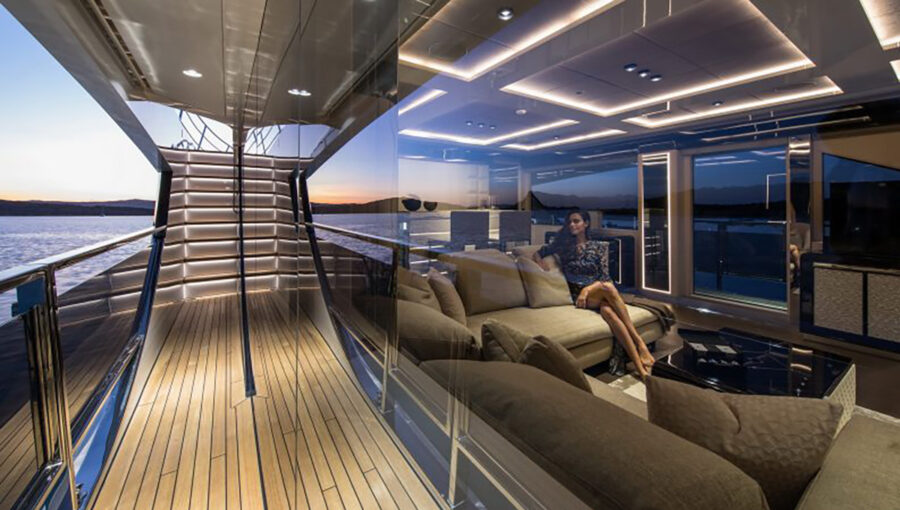Commissioning a custom yacht transforms a personal vision into a tangible masterpiece of maritime engineering and luxurious craftsmanship. This report guides you through every critical phase, from the initial idea to the moment your dream yacht glides into the water. Building a custom yacht is a complex, multifaceted process requiring a comprehensive understanding of naval architecture, structural engineering, and material science, representing a significant investment of time, resources, and personal commitment.
The Importance of the Owner’s Specification
The first “design task” for a prospective owner is to formulate their vision and create an “Owner’s Specification” or “Mission Statement”. This foundational document defines the yacht’s intended use, operating waters, desired speed, range, number of passengers and crew, and overall aesthetics. It should be as detailed as possible, including the number of cabins, noise levels, and preferred finishes. While the owner’s initial specification is a dream, a naval architect must balance this with sound design principles and an understanding of the sea to ensure feasibility. This initial specification is not static and will be reviewed and adjusted throughout an iterative and collaborative design process. Owners must be prepared for a flexible and adaptable design process, understanding that initial concepts will be refined through expert input to ensure feasibility, cost-effectiveness, and seaworthiness. Early engagement and willingness to adapt are crucial for a successful outcome.

The Role of the Owner’s Representative
Given the complexity of a custom build, engaging an experienced, conflict-free team of experts is paramount. This team often includes a specialized yacht brokerage firm, a project manager, and potentially a future captain or engineer. The owner’s representative acts on behalf of the owner, overseeing the shipyard’s project manager, tracking progress, managing budgets, and ensuring adherence to the schedule and specifications. They are crucial for communication and meeting decision deadlines. An owner’s representative, especially with a nautical or engineering background, bridges the knowledge gap in the technical maritime industry, ensuring the owner’s interests are understood and protected. Without this expert oversight, the owner risks cost overruns, delays, or deviations from their vision. Although associated with additional costs, a professional owner’s representative is an investment that safeguards the primary investment by ensuring quality, adherence to specifications, and financial control throughout the multi-year construction process. Their presence transforms the owner’s role from a passive recipient to an informed decision-maker.

Phase: Design – Shaping the Soul of Your Yacht
The design phase is where your abstract vision takes concrete form through a highly collaborative process involving naval architects, yacht designers, and engineers.
Conceptual Development: From Sketch to First Vision
This initial phase involves creating sketches and concepts, considering the yacht’s intended use, operating environment, and capacity. The designer gathers ideas, researches, and evaluates concepts based on feasibility, cost, and aesthetic appeal. Concept sketches, 2D profile/top views, and initial 3D models define the overall shape, layout, and style. The focus is on defining the desired onboard experience, balancing overall aesthetics with technical considerations like naval architecture, structural engineering, and material science. This “discovery process” involves mutually finding the best solution, constantly checking aesthetic desires against technical realities such as hydrostatics, stability, and performance. This iterative balancing act ensures the yacht is not only beautiful but also safe, stable, and capable, making early collaboration with naval architects crucial.
Technical Planning & Visualization: The Blueprint Emerges
Once the designer settles on a concept, detailed 3D visualizations and photorealistic renderings are created, allowing clients to visualize materials and spaces before physical construction. This phase includes critical technical calculations by naval architects and engineers:
- Weight Estimation: A comprehensive and refined estimate of the yacht’s weight, accounting for all materials and components, down to the smallest detail.
- Structural Calculations: Rigorous calculations to determine the yacht’s strength and stability, considering weight, forces (e.g., wave impacts), and materials. Stability calculations ensure the yacht remains upright and stable by determining its center of gravity and metacentric height. The hull form, beam, and ballast placement significantly influence stability and motion.
- Resistance and Powering Calculations: These determine the yacht’s hydrodynamic resistance and the power needed for desired speeds. Advanced tools like Computational Fluid Dynamics (CFD) and physical tank testing are used for precise hydrodynamic analysis. Specialized software like Maxsurf is used for hull modeling, analysis, and rapid refinements.
Computer-generated models also facilitate creating scaled physical models for further testing or styling verification. Detailed manufacturing drawings for every component and a comprehensive Bill of Materials (BOM) are compiled. The use of 3D modeling, CAD/CAM, and computer-controlled cutting signifies a fundamental shift, creating a “digital twin” of the yacht. This digital twin allows for subtle refinements, ensures accurate fit, reduces welding distortion, and significantly saves labor time in hull fabrication. It also supports complex structural calculations and material optimization, enhancing precision, efficiency, and cost-effectiveness. Owners benefit from fewer errors, faster construction, and a more accurate realization of the design.
Interior & Exterior Design: Luxury and Functionality Combined
The design encompasses both external appearance and interior layout, crucial for the overall experience.
- Exterior Design: Defines the yacht’s overall styling, lines, shape, and superstructure features, aiming for an appealing aesthetic that reflects the client’s vision. Mood boards and 3D models explore options.
- Interior Design: Transforms the yacht into a “luxurious floating home,” maximizing space within dimensions while ensuring everything is secured and stable against sea motion. Key elements include layout, material selection, and effective use of color and light. Multifunctional areas, foldable furniture, and hidden storage optimize space. Materials must be stylish, lightweight, and durable (e.g., teak, aluminum, stainless steel, quartz) to avoid compromising balance and performance, considering temperature, humidity, and movement. Lighting design creates ambiance, and advanced smart systems for navigation, entertainment, climate control, and security are integrated. Custom cabinetry and thoughtful details personalize the space.
Interior and exterior design are interconnected; interior elements must be “secured and stable” and “lightweight” to maintain balance and performance, while exterior design considers overall size and suitability. This holistic approach ensures functionality, safety, and performance are never sacrificed for style. Every design decision impacts the yacht’s overall performance, stability, and safety. A truly custom yacht seamlessly integrates these aspects, requiring close collaboration between stylists, naval architects, and engineers from the outset.

Phase: Shipyard Selection & Contract Negotiations – Finding the Right Partner
Selecting the right shipyard is as crucial as the design, determining construction quality, adherence to schedules, and overall project success. This phase requires thorough due diligence and meticulous contract negotiations.
Criteria for Shipyard Selection
Choosing a shipyard is a monumental decision impacting quality, cost, and timeline. The emphasis on “chemistry,” “after-sales support,” and build duration suggests a long-term partnership. Consistency and trust are paramount, as a “revolving door of employees” can lead to a “fractured process”. Owners should prioritize shipyards demonstrating technical prowess, strong customer service, transparent communication, and a stable, experienced team for peace of mind during the build and throughout the yacht’s lifecycle.
Contract Drafting & Financing
The construction contract must be based on a meticulously detailed yacht design and specification, with every centimeter approved before construction. Financial terms, payment schedules, and warranties must be carefully analyzed to protect the owner’s interests. Most privately used superyachts are financed through bank loans. The contract should clearly define how change orders will be negotiated to ensure budget adherence and avoid delays. It should also define when the risk of damage or liabilities transfers from builder to owner. Owners need employer’s liability insurance for the crew once engaged. It is highly advisable to involve yacht insurance representatives and classification society surveyors from the beginning. Early consideration of the yacht’s flag state for registration is crucial. For example, a USCG Yacht Documentation Certificate provides protection under the US flag, facilitates clearance abroad, and establishes clear title and ownership history. It is often required by banks for financing and must be renewed annually. Vessels for hire have specific USCG documentation requirements. The contract terms must be legally sound and comply with maritime laws where the yacht will operate. When a private yacht transitions to charter, it must adhere to more stringent regulations, including licenses, certifications, annual inspections, and crew requirements. Private yachts also must meet safety and environmental standards. Legal implications, including asset protection, are considered alongside technical construction. Financing, documentation, insurance, and regulatory compliance are integral to project success and future operation. Incorrect documentation, for instance, can impact financing or legal operation. Owners must engage legal and financial experts specializing in maritime law and yacht financing from the outset. This proactive approach ensures solid legal and financial frameworks, mitigates risks, enables smooth transactions, and prepares the yacht for its intended operational profile.

Phase: Construction – From Keel to Completion
This is the most tangible phase, transforming designs into physical structures through precision engineering, skilled craftsmanship, and rigorous quality control.
Hull & Superstructure Construction
Physical construction begins with the hull, often welded upside down and then flipped. Hull materials include steel (strong, durable, for larger vessels), aluminum (lightweight, corrosion-resistant, for high-performance yachts), or fiberglass/composites (versatile, cost-effective, with advanced composites offering lightweight, high-performance structures). Superstructures are usually built separately from the hull, often from aluminum for larger yachts, then craned into place and homogeneously welded or bonded. Construction involves precise cutting (often computer-controlled laser or plasma cutting), assembly, and welding. Hulls are often over-specified in strength, with monolithic construction around keel structures and slamming zones for ultimate durability and seaworthiness. Material choice dictates construction methodology, influencing structural integrity, weight, performance, and longevity. For example, aluminum requires greater welding skills than steel, and computer-controlled cutting reduces labor and improves fit. Material selection is a fundamental engineering decision impacting the entire construction process, shipyard skills, and the yacht’s long-term characteristics, and should be made early in consultation with the naval architect.
System Integration & Interior Fit-Out
This phase significantly overlaps with structural work.
- Machinery & Systems: Larger machinery like engines, generators, propulsion systems, and air conditioning units are installed before the superstructure fully encloses interior spaces, requiring thoughtful positioning for optimal function and ease of maintenance.
- Piping & Wiring: Installation of cable trays and pipework is a carefully choreographed process. The electrical power distribution system must be meticulously planned for extensive power requirements.
- Interior Fit-Out: Involves intricate joinery, insulation, lighting systems, and the installation of luxurious yacht interiors. Interior panels are often prefabricated and designed for easy removability for future access and maintenance. Custom-made, multifunctional furniture, professional bar equipment, and outdoor cooking appliances are integrated to maximize comfort and utility.
- Deck Equipment: Installation of deck fittings like cleats, winches, navigation lights, and railings requires precision. Holes in cored decks are drilled oversized, filled with epoxy, and re-drilled to prevent water intrusion. Specialized sealants ensure watertightness and prevent galvanic corrosion, especially with dissimilar metals. Installing a teak deck involves meticulous preparation, adhesive application, expert caulking, and final sanding.
While aesthetics are important, the information emphasizes “function and serviceability,” “accessibility,” and ensuring components are “accessible without tearing apart finished interiors”. The need for “prefabricated and removable” interior panels and photos of “what’s behind the panels” highlights the challenge of integrating complex systems within confined spaces while maintaining future maintenance access. This requires meticulous planning and coordination. Owners should scrutinize the shipyard’s plans for system integration and maintenance access during design and contract phases. A well-planned and executed system arrangement is crucial for long-term reliability, operational efficiency, and reduced maintenance costs.
Quality Control & Classification
Throughout construction, adherence to strict standards from classification societies (e.g., DNV GL, Lloyd’s Register, ABS) for welding, quality control, and structural integrity is paramount. These societies independently monitor and certify the yacht is built to the highest industry standards for safety and quality. Naval architects coordinate and submit information to regulatory bodies for required certificates. The shipyard’s internal project manager and the owner’s representative work closely to ensure structured processes, clear responsibilities, and consistent quality standards. Regular progress reports, often with photographic documentation, align construction with the schedule and specifications. Adherence to regulatory requirements and classification society standards is fundamental for quality control and risk mitigation. Involving insurance representatives and classification society surveyors from the beginning avoids unnecessary hassle, ensuring the yacht is built to the highest standards, impacting safety, seaworthiness, resale value, and insurance premiums. Owners should view regulatory compliance and classification as an integral part of the yacht’s value proposition and safety. Early involvement of a build captain or engineer brings a “seagoing perspective,” integrating practical operational considerations into design and build, enhancing long-term value and usability.

Phase: Launch & Handover – Your Dream Yacht Sets Sail
This culmination of years of design and construction involves rigorous testing, final adjustments, and formal handover.
Sea Trials & Acceptance Tests
Upon completion, the yacht is launched. Sea trials are critical, monitored test runs in open water to evaluate operational readiness, performance, seaworthiness, and handling under real-world conditions. They are typically mandatory and rigorously test:
- Propulsion and Maneuverability: Main engine responsiveness, shaft alignment, thruster performance, turning circle, crash stop, engine noise, and temperature.
- Stability and Comfort: Evaluation of behavior in various conditions, stability, roll period, and overall comfort.
- Speed and Performance: Measurement of top speed, acceleration, and fuel consumption to verify contractual performance.
- Navigation and Communication Systems: Thorough check of all electronics.
- Electrical and Mechanical Systems: Testing of electrical load distribution, generators, and other systems.
- Safety and Emergency Systems: Live testing of firefighting equipment, life-saving appliances, watertight integrity, and alarms.
- Hull Integrity: Inspection for leaks or other issues.
Sea trials identify functional issues not apparent during dockside testing and verify compliance with classification society, flag state, and insurance requirements. Objective data on performance and system response times are collected. Owners or their representatives should participate in sea trials, ideally under conditions closest to intended use. Sea trials are the ultimate “shakedown cruise” where “theory meets real-world conditions,” crucial for “risk mitigation” by identifying “failure points before owner delivery” and protecting “warranty claims by establishing baseline performance”. The meticulous nature of tests, including 24-hour passages and simultaneous system checks, ensures “operational confidence” and mitigates “extensive warranty snags”. Owners should insist on comprehensive sea trials and consider engaging independent surveyors to verify performance. This final testing phase is the last opportunity to address issues before acceptance, directly impacting reliability and peace of mind.
Commissioning & Handover to the Owner
After sea trials, a comprehensive “snagging list” is compiled and addressed with the shipyard. Commissioning is a time-consuming and meticulous process, involving extensive checks beyond sea trials, often including real sailing situations and simultaneous system operation. The handover process is intense, familiarizing the owner (or captain/crew) with every aspect of the yacht, including detailed walkthroughs, practical demonstrations, and provision of spare parts and documentation. This marks a transition to operational mastery and confidence. The detailed walkthroughs and explanations ensure the owner feels “confident with their yacht” and enjoys it from the moment they take the helm. This phase equips the owner with the knowledge to operate and maintain their complex yacht. Owners should allocate sufficient time and resources for commissioning and handover, ideally involving their future captain and crew, ensuring a smooth transition, minimizing post-delivery issues, and maximizing enjoyment and safe operation.
Legal Aspects of Commissioning
Before final launch and delivery, yacht insurance representatives and classification society surveyors must confirm readiness and compliance. Legal and regulatory requirements do not end with the launch but become an ongoing operational burden, especially for charter yachts, including routine class and flag inspections, audits, and management fees. Vessel registration in the country of primary operation is crucial for international chartering and recognized nationality. Various documentation options exist for specific charter or operational purposes. This suggests that “launch” is the beginning of an operational journey requiring constant vigilance and budgeting. Owners, especially those considering chartering, must factor in the long-term costs and responsibilities of maintaining legal and regulatory compliance. This underscores the need for a dedicated management team or captain familiar with maritime regulations to ensure continuous operational readiness and avoid legal pitfalls.

The Realization of Your Maritime Dream
Building a custom yacht is an extraordinary journey that transforms personal aspiration into a magnificent reality, a testament to vision, collaboration, and the pinnacle of maritime engineering and craftsmanship. From initial sketch to triumphant launch, every step is an intricate dance between artistic design and technical precision. Success hinges on meticulous planning, selecting trusted partners (designers, naval architects, reputable shipyards), and diligent oversight. Embracing the iterative nature of design, understanding the interplay of materials and systems, and prioritizing rigorous quality control and comprehensive testing are paramount. Your custom yacht is more than a vessel; it is a meticulously crafted extension of your unique lifestyle and dreams, ready for countless adventures. With the right team and a clear understanding of the process, your journey from concept to launch will be as rewarding as the destination itself.









